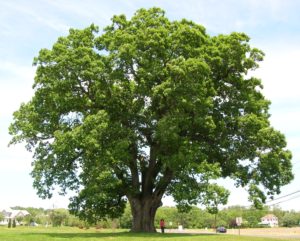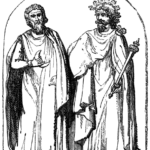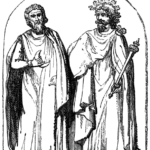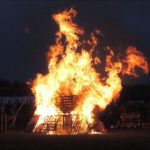The sacred Celtic calendar trees are rich in mythological history and have inspired many traditions in folklore, from using their wood as divining rods to inheriting wisdom and universal understanding from their seeds, fruits, and nuts.
Ten of the Celtic Moon months are governed by a sacred tree. Each tree has its own unique magical associations, sprung from the environmental conditions in which it grows, and from the seeds and fruits it bears.
Birch (24 Dec 20 Jan)
The Celtic calendar starts the New Year with the month of the Birch Moon, signifying a time of renewal.
The Birch is often known as the Lady of the Woods’, and signifies new beginnings, an association springing from the fact it is the first tree to grow back after a forest has been burned. The birch also sheds its bark, which suggests further links to renewal, as the old and worn-out is released to make way for the new. Traditionally, couples used to marry by jumping over a birch twig brush to symbolize their new beginning together in life.
Rowan or Mountain Ash (21Jan 17 Feb)
Rowan berries bear the magical pentagram an important symbol in magical traditions.
Due to the conditions in which it grows, the Rowan tree symbolizes tenacity. It is found growing high up on the sides of mountains, often sprouting from tiny crevices in inaccessible spots. The Rowan berry has a tiny five-pointed star or pentagram opposite its stalk. This explains why it was worn, hung in doorways, or planted near houses to offer protection against evil forces.
Ash (18 Feb 17 Mar)
The Ash is thought to hold the key to universal knowledge and understanding through its winged seeds.
The Ash tree is the Tree of Life’ and its winged seeds, called keys; represent the key to universal understanding. The tree is also believed to cure warts: prick the tree with a pin; then use the pin to cross the warts three times saying, “Ash tree, ashen tree, pray buy this wart off me”, then put the pin back in the tree. Hopefully, the warts will swiftly disappear.
Alder (18 Mar 14 Apr)
The alder was part of the legendary battalion of trees that fought against dark forces.
In Welsh mythology, the alder fought in the front line of the Battle of the Trees’, against the Underworld. When cut, its wood turns from white to red as though it is bleeding. Growing near water, the tree has feminine association, yet its links to war also indicate masculinity. The Alder therefore speaks of balancing masculine and feminine.
Willow (15 Apr 12 May)
The willow tree has strong associations with water and its wood can be used for water-divining.
Willow symbolizes regeneration as cut willows always re-sprout. It is so highly flexible that the wood has traditionally been used for making baskets. As a water-loving tree, willow signifies emotional balance. Deserted lovers would
Wear the green willow’ to share their grief with others. Its wood is also good for making magic wands.
Hawthorn (13 May 9 Jun)
The period of year ruled by Hawthorn signifies rebirth since the tree’s wood was used in May Day festivities.
The coming of the may blossom at Beltane signifies new life and the onset of the growing season. Knots of May’, armfuls of may blossom, were used to decorate doorways and make garlands for the traditional Maypole. It is considered unlucky to bring May blossom into the house; however, as its spring hopefulness should not be confined indoors.
Oak (10 Jun Jul)
The Oak tree is also linked to the Summer Solstice its wood fueled the sacred Midsummer fires.
 The slow-growing Oak is known as the king of the forest’. With its huge height and wide girth, the tree represents strength, courage and wisdom. The Druids revered the tree and held meeting in Oak groves. In the Ogham alphabet, the word duir’, which means door, is linked to the Oak, and thus links the tree as the doorway to knowledge and wisdom.
The slow-growing Oak is known as the king of the forest’. With its huge height and wide girth, the tree represents strength, courage and wisdom. The Druids revered the tree and held meeting in Oak groves. In the Ogham alphabet, the word duir’, which means door, is linked to the Oak, and thus links the tree as the doorway to knowledge and wisdom.
Holly (8 Jul 4 Aug)
The prickly leaves of the Holly match its formidable, masculine associations as a tree of protection and warfare.
Holly is traditionally used to decorate the home at Winter Solstice. Its red berries and green leaves in the dead of winter symbolize everlasting life. A Holly tree growing near the home is thought to provide protection from thunder, lightning and demons. A masculine tree, its wood was also used to make spears and chariot wheel in ancient times.
Hazel (5 Aug 1 Sept)
The salmon of knowledge was believed to have swallowed the hazelnuts of wisdom while swimming in the Well of Segais.
Hazel wood is pliant and has traditionally been used for divining underground water. A hazelnut on a string also makes a good dowsing pendulum. Celtic legend talks of nine hazelnuts of wisdom, which fell into a sacred pool and were eaten by a salmon. Whoever ate the salmon would then receive infinite wisdom.
Elder (25 Nov 23 Dec)
The Elder tree links life and death in the Wheel of the Year, and represents closure and completion.
The Elder tree re-grows damaged branches easily and can root from any part of itself. For this reason, as the final tree in the Wheel of the Year, it represents the joining point where life and death meet. Traditionally, witches could transform themselves into Elder trees and so it is unlucky to cut them down.
Three of the 13 Celtic Moon months are governed by plants other than trees, and these months are:
Vine Moon (2 Sept 29 Sept)
The month of the Vine Moon marks the turning point in the year when the days begin to shorten. It is a time to harvest the rewards of all your efforts throughout the year so far.
The name vine comes from the word viere’, meaning to twist’. This refers to the Druidic concept of spiritual development.
Ivy Moon (30 Sept 27 Oct)
During the month of the Ivy Moon, accept that the challenges you face make you stronger. It is an opportune time to give thanks for life’s blessings and to prepare for a period of spiritual growth.
Ivy grows in a spiral formation reminding us that each cycle of the seasons brings us closer to the center, to the spirit. The last harvest sheaf to be cut in the village was once bound with ivy and called the Ivy girl’. This was given to the farmer whose harvest was last, as a reminder of his responsibility to the spirits of the land.
Reed Moon (28 Oct 24 Nov)
The month of Reed is a time for pause. It allows you to reflect on what has passed before the start of another year.
In the past, the reed was used to make swift-flying arrow shafts that slew both enemies and game. In this way the plant was linked to the season of death and sacrifice, in which trees shed their leaves and the energy of nature, became more introspective. Many early musical instruments also used the reed to create a haunting sound that has been connected to rites for the dead and the summoning of spirits.






